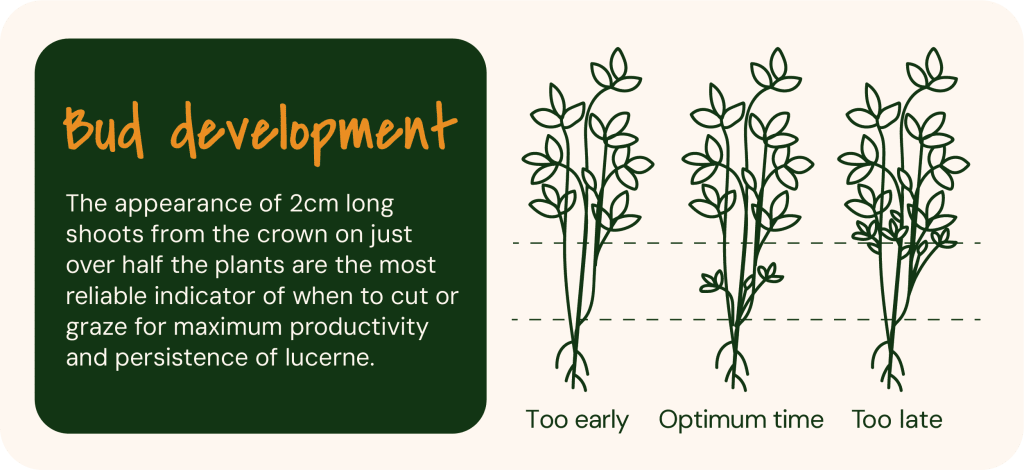Lucerne Advisor Series: Managing your first season lucerne for longevity
August 26, 2025 Australia
Lucerne’s establishment year isn’t about yield, it’s about building a stand that lasts. What happens in the first 6–12 months sets the tone for the next 4–7+ years of production.
From crown development to grazing timing, here’s how to manage young lucerne for long-term performance.
Build the crown, build the stand
Lucerne persistence starts below the surface. In its first year, lucerne:
- Establishes a deep taproot
- Forms a crown from which all future shoots will grow
- Stores energy reserves that drive regrowth and resilience
Cutting or grazing too early can damage developing crowns, reduce root growth, and lead to early plant death, even if the stand looks strong on top.
Longevity tip:
- Dormant & semi-winter-dormant varieties can persist for 7+ years with good management
- Winter active types typically last 5–7 years
- Highly winter active lucerne will often persist 3–4 years
When to graze or cut: timing is everything
Lucerne should only be grazed or cut once it’s properly established and ready to recover. Key indicators:
- Shoots are 2cm long from the crown on at least 50% of plants
- Plants are well anchored and resist pulling from the soil
- Root nodulation is clearly visible (check a few plants)

Avoid:
- Grazing during wet conditions (increases crown damage)
- Grazing immature stands
- Cutting too low or too often in year one
For maximum longevity, aim to cut at mid-bud to early flower. Let it reach mid-flower before your final autumn cut.
Watch for weeds and insects early
In its first few months, lucerne is highly susceptible to:
- Weed competition: especially capeweed, wireweed, barley grass
- Insect pressure: redlegged earth mite, lucerne flea, blue green aphid
To protect your young stand:
- Use pre-sowing knockdowns and pre-emergents (e.g. Trifluralin)
- Monitor frequently and control early, damage often goes unnoticed until it’s too late
- Sow pest-resistant varieties like L56® or L97, which offer strong resistance to Phytophthora and key aphids
- Choose seed treated with an insecticide like XLR8® for an added layer of protection against early-season pests. Every AlfaGen lucerne variety comes with XLR8® seed treatment – a film coating of Poncho® Plus insecticide, designed to give seedlings the best possible start.
Support the system with nutrients
Lucerne removes large amounts of nutrients, even in its first year. If you don’t replace what’s lost, stand persistence suffers.
Fertility tips for establishment:
Apply starter phosphorus (P) and molybdenum at sowing to support early root development and nodulation.
After your first cut or graze, apply potassium (K) and additional phosphorus based on expected yield.
Rule of thumb:
Apply 6kg of P and 25kg of K for every tonne of lucerne hay removed.
Use soil and tissue testing to fine-tune inputs, especially for potassium and sulphur. Deficiencies in these nutrients often show up too late to fix, but they reduce regrowth and persistence from the start.
Common early mistakes (to avoid)
Grazing too early or hard
Stresses crowns before they’re ready, shortens stand life.
Skipping weed control
Lucerne doesn’t compete well early. Give it the clean run it needs.
Underfeeding
Lucerne takes a lot out of the soil. Replacing nutrients in year one is essential.
Cutting too often
Only cut once or twice in the first year, and let it flower before winter.
Product spotlight: varieties that support persistence
- L56® – With its low and broad crown and excellent pest and disease rating, L56® can produce high-quality hay or a persistent grazing paddock, depends on your needs
- L97 – A highly winter-active performer for cut-and-carry systems, suited to short-to-medium rotations
- Goldstrike XLR8® – Seed treatment on all AlfaGen lucerne varieties, combining insecticide and fungicide protection and rhizobia inoculation to build nodulation and root strength
Conclusion
A lucerne stand can give you four to ten years of reliable feed, or just two. The difference often comes down to what happens in the establishment year.
Get the first season right by:
- Grazing conservatively
- Controlling weeds early
- Feeding the plant for future persistence
Keep your lucerne thriving
The first year is critical, but there’s more you can do to set your stand up for the long haul. Explore more advice from the Lucerne Advisor Series:
- Why tiller density matters for lucerne persistence
- When to cut and how to feed lucerne for value
- Lucerne in rotation – how to know when it’s time
Not sure when to graze or how to read your stand?
Talk to your local AlfaGen Seeds Territory Manager for support, or explore our full lucerne guide online.